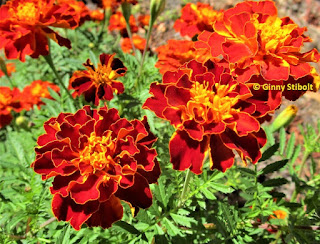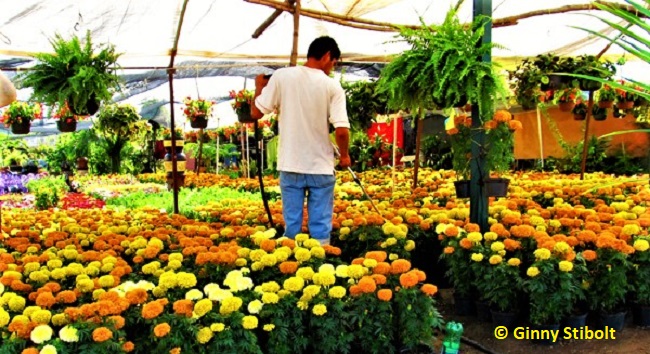 |
| Beautiful marigolds! |
Inchworm by Danny Kaye
Inchworm, inchworm (two and two are four)
Measuring the marigolds (four and four are eight)
You and your arithmetic (eight and eight are sixteen)
You'll probably go far (sixteen and sixteen are thirty-two)
Inchworm, inchworm (two and two are four)
Measuring the marigolds (four and four are eight)
Seems to me, you'd stop and see (eight and eight are sixteen)
How beautiful they are (sixteen and sixteen are thirty-two)
Marigolds have been under cultivation for centuries
Marigolds (Tagetes spp.) are members of the daisy family, Asteraceae. They are all native to the Americas: Mexico, Central America, and South America, but some of the common names imply otherwise. Some are called French marigolds or African marigolds. In their Plants of the World Online, Kew Gardens states that there are 49 species. But only a few species have been widely cultivated including the so called French Marigold (T. patula), the so-called African marigold (T. erecta), the signet marigold (T. tenuifolia), and Mexican tarragon or sweet mace (T. lucida). Recently most botanists including Kew Gardens and the Atlas of Florida Plants have decided that the French marigold (T. patula) is the same species as the African marigold (T. erecta), with a better common name: Aztec marigold.
 |
| A woman buys a huge bunch of marigolds to decorate relatives' graves on Nov. 1 Day of the Dead. |
Marigolds and festivals
Marigold flowers don't wilt after they are picked and they hold their color for many days and this asset means that marigolds became important for various festivals in their native regions, Mexico and Central America, especially the Día de Muertos (Day of the Dead on Nov. 1 & 2). This celebration was begun during the time of the Aztecs, but was synched up with the Christian All Saints Day. Both days 1 and 2 are national holidays and the kids don’t go to school. On the first day, people go to the cemeteries to clean up their relative's graves and decorate them with marigolds and other flowers.
A few years ago, my husband and I were in Huatulco, Mexico (on the southwestern coast) on November 1. Markets and pickup trucks were filled with marigolds. People were buying huge bunches of them. The woman in this photo bought an armload of marigolds that was almost as big as she was.
Nov. 2, the second Day of the Dead, is for the children. On this day that year, we were in Antigua, Guatemala and saw the the markets were selling kites and then we saw the kids flying kites in the cemeteries to stay in better touch with their dead relatives. Very touching.
 |
| A flower market on Nov. 1 in Huatulco, Mexico is ready for an onslaught of customers. |
 |
| On Nov.2, the second Day of the Dead, kids fly kites in the cemeteries. This is in Antigua, Guatemala. |
Marigolds have been on the move!
Other parts of the world also use marigolds for festivals and religious offerings. | |
| Marigolds are strung together and used for offerings in Hindu temples. This is in Mumbai, India. |
 |
| Marigolds and other flowers are strung together and used for offerings in Buddhist temples . This is in Kuala Lumpur, Malaysia. |
 |
| Marigolds as companion plants |
Marigolds in the garden
Marigolds are popular plants in the garden for a number of good reasons. Note: Whether you're using marigolds for pollinators or as an edible, if you buy plants rather than seeds, make sure they have not been treated with systemic insecticides such as neonicotinoids.
For decoration in flower beds because their bright-colored flower heads last for days and they have a long blooming cycle in warm weather. And, as mentioned above, they last a long time when cut for bouquets.
To eat. All the commonly available marigolds have edible flowers—just cut the petals or ray florets from the top of the flower head to use in salads or to add color to any dish. For the Mexican tarragon (T. lucida) in addition to the flowers, the leaves have a complex flavor and odor that's somewhat like anise/tarragon, but with a hint of mint.
As companion plants in vegetable gardens:
- to attract pollinators,
- to ward off pest bugs,
- to fill in to reduce weeds,
- to reduce soil pathogens because the roots exude antibacterial substance, so don't plant near legumes because plants in the bean family depend upon bacteria to fix nitrogen.
As a cover crop to reduce root-knot nematodes. Just planting marigolds as a companion plant will not do much to reduce nematode populations. Grow the marigolds in a bed and at least two weeks before planting the fall crops, turn the marigolds into the top few inches of soil. For the details, read this article: Results: the nematode experiement
As a dye for fabrics or other materials. Their strong pigments are even used as chicken feed to color chicken meat.
 |
 |
| A monarch butterfly (Danaus plexippus) | A southern carpenter bee (Xylocopa micans) |
In addition to pollinators, marigolds also attract predators. A few years ago a wicked looking green lynx spider and all her babies occupied my marigolds during the fall months. This was fun to watch.
 |
| A green lynx spider mom, spent several months in our marigolds raising her babies. The babies here are in two bunches protected under the marigold flowers with a web spun around both flowers. Read my post on the spider-mom saga. |
 |
| Burpee's white marigold, "Snowball." |
The quest for a white marigold
Marigold flowers are naturally yellow/orange/dark red and most of the many cultivars also had these warm color tones. Burpee Seeds began a contest to produce a white marigold with a $10,000 prize in 1954—a type of citizen science experiment—where its customers (including my mother), would buy the lightest yellow marigold seeds and if they grew a white one, they sent the collected seeds back to Burpee. Their growers tested the seeds to see if it yielded marigolds that were light enough to be called white. This quest for a white marigold lasted for quite a while until the prize was finally awarded in 1975. You could buy a nice house for $10,000 in the 1950s—it was a lot of money. So my mother grew fields of those pale marigolds for many years.
So I hope you'll add more marigolds to your yard to attract pollinators, to repel nematodes, to eat, to gather for flower arrangements, or to simply add beauty to your yard.
Marigolds by Southern Exposure
Marigolds by Burpee Seeds in addition to their white cultivar, they also offer one that is said to be a better deterrent to nematodes.
Green Gardening Matters,
Ginny Stibolt



This was delightful to read. Thank you for sharing!
ReplyDelete